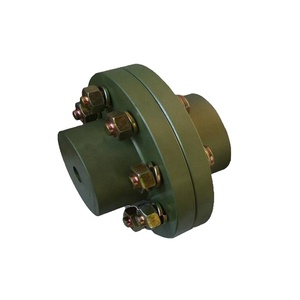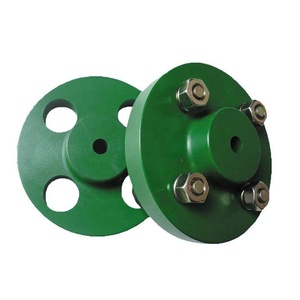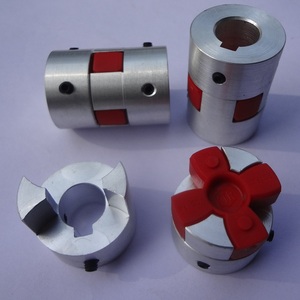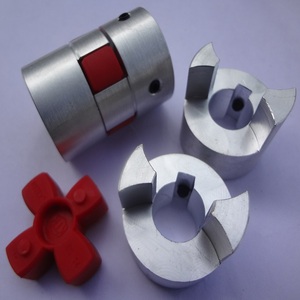(938 products available)













































































































































































There are several types of flexible couplings available in the market today. The differences in flexibility, material, construction, and application make them suitable for particular requirements. Below are the most common types of flexible couplings.
This is a very easy to install and very popular power transmission solution. It uses a tapered keyway system. These taper lock keyways are installed into the pulley or hub. After this, the hub is fitted onto the shaft. The taper lock keyways used on the pulley or hub create a very firm and secure grip on the shaft. This eliminates the need for any additional setscrews or keys to help with the coupling connection.
These flexible couplings are rigid, strong, and durable and are used to transmit torque over long periods and distances. Being metallic means they can withstand very high temperatures. Also, due to the metal construction, flexible couplings are resistant to environmental issues such as dirt, dust, and water and are not easily damaged by cutting or abrasions.
However, it should be noted that while metallic flexible couplings are robust, they do not absorb shocks or vibrations as well as some other types of couplings. This makes them suitable for high-precision applications.
This is made of two metal (or one metal and one plastic) parts with teeth that mesh with an elastic insert between them. It reduces misalignment by allowing limited angular, parallel, and axial displacement between the connected shafts. The rubber or elastic material provides excellent dampening of shocks and vibrations and helps absorb surges in torque. This makes jaw flexible couplings ideal for use in motors, gearboxes, pumps, and other heavy-duty equipment.
It is designed to continue transmitting torque even when the coupling fails. This is available in various designs, including elastomeric, disk, and bellows couplings. In the case of a flexible coupling, which is usually made of elastomeric or rubber materials, its fail-safe design may include metal pins or a secondary support structure that will take over torque transmission when the rubber part becomes damaged or worn out.
This has an octagonal elastomer or rubber vibration absorption and dampening insert between two hub halves. It is specially designed to accommodate angular, parallel, and axial misalignments by allowing slight movements in different directions. The octagonal elastomer insert provides elasticity in all directions. This absorbs shocks, vibrations, and noise and dampens the pulsations of torque.
Choosing the right flexible coupling for an application involves considering various factors. These factors include operational needs, misalignment situation, and mechanical requirements. Below are some of these factors in detail.
One needs to consider the operating conditions under which the coupling will be used. These include the speed and load that the application demands. One should choose a fcl flexible coupling that can handle the operating torque and power effectively. Also, consider the temperature range, as certain couplings are specifically designed to withstand high heat.
As various flexible couplings have been designed to accommodate different shaft misalignments. For instance, angular misalignment requires couplings such as the flex-grid or elastomeric type. Parallel misalignment, on the other hand, can be corrected by using a coupling with a flexible element. Choose a coupling that suits the specific alignment issue likely to be experienced in that application.
If the application will experience any significant shocks, vibrations, or loads, one should consider a coupling with a dampening feature. Couplings like the elastomeric type and the gear type are better in absorbing these shocks than others. If the application involves fluctuating loads or pulsing torque, ensure that the flexible coupling can effectively absorb and cushion these variations.
The material that a coupling is made of should be compatible with the environmental conditions it will be exposed to. For example, stainless steel or other metal couplings are preferred in harsh and environments where chemicals are likely to be encountered. On the other hand, if the environment has high levels of moisture, water, or particulate matter, choose a coupling that is easy to maintain and clean.
There are dynamic and static loads, and different types of loads require different coupling solutions. If the application in question has a changing load or starting heavy load, one should consider using a coupling that is specially suited for these applications. Where the load is remaining constant, one has the liberty of choosing any coupling that suits the other requirements.
Fcl flexible couplings have different specifications, and understanding them is vital for clients. These specifications determine how flexible couplings perform in particular applications. Below are some of the various specifications.
This is the maximum amount of torque or force that a coupling can carry. It is measured in Newton-meters (Nm) or pound-feet (lb-ft). Exceeding the load capacity will result in coupling failure, meaning it is important to select a coupling with adequate load capacity to meet operational requirements.
Flexible couplings have been made using various materials: metal, rubber, and composite materials. Each of these materials has its advantages and disadvantages. Metals, for instance, offer high strength and stiffness and have elasticity that will tolerate small misalignments. Rubber-based or elastomer couplings provide better isolation of shock and vibrations.
These are the types and amount of misalignment a coupling can tolerate. Various flexible couplings accommodate different misalignment types: angular, parallel, and axial. Some couplings, like the diaphragm or disc types, handle limited amounts of misalignment. In contrast, others, like the gear or elastomer types, are designed to absorb more misalignment.
This is typically determined by coupling materials. For instance, metallic couplings often withstand higher temperatures than rubber or plastic ones. Knowing the operating temperature range is vital because it will help determine if the coupling will be suitable for an application where the ambient temperature fluctuates widely or where there is a heat source.
This is the coupling's ability to transmit rotary force, alternatively called torque. The torque value of a flexible coupling mostly depends on the material it is constructed from and the design. Torque values show how much load or force the coupling can handle in rotating motion. One cannot afford to choose a coupling that cannot handle the required torque for that application.
Flexible coupling sizes range from very small to large. The size of the coupling one goes for will depend on the shaft's diameter that the coupling has to connect. Larger couplings handle larger loads and torques, while smaller ones are more suited to light-duty applications.
Fcl flexible couplings are used in various industries and applications. This is due to their ability to compensate for shaft misalignment, transmit torque, and absorb shocks and vibrations. Below are the common applications for these couplings.
One of the most common uses of Fcl flexible couplings is in industrial machines. Things like pumps, compressors, conveyors, and fans all benefit from using these couplings. The couplings help to reduce the misalignments that inevitably occur between the shafts of the driving motor and the driven equipment.
In the automotive field, the flexibility of these couplings provides the dampening and isolation of vibrations and shocks that would otherwise travel from the engine through the drivetrain to the rest of the vehicle. This makes for a much smoother and quieter ride. These couplings are found in places like the driveshaft, where they connect to the differential or gearbox and even in power steering systems.
Couplings in aerospace need to be very strong but lightweight. Fcl flexible couplings find their application in controlling systems. In these applications, small misalignments have huge consequences. Aerospace operators trust fcl flexible couplings to give them the precision and reliability they require to keep their aircraft safely in the air.
Robots are usually equipped with motors that drive various parts or end-effectors. These motors will need to be connected to the control systems using Fcl flexible couplings. In robotics, these couplings help ensure that movements are accurately transmitted from the motor to the part that is moving and that any vibrations are absorbed so that the operating precision is maintained.
Wind turbines and other renewable energy systems use these couplings. The turbines have blades that capture the wind's energy and a rotor that turns as a result. The rotor is connected to a generator using a flexible coupling. Turbines and the winds they capture are not always perfectly aligned. That is why Fcl flexible couplings are essential in these renewable energy systems.
Boats and ships rely on flexible couplings to connect engines and propeller shafts and drive systems. The dynamic environment of water and the vessel motion causes misalignments. Fcl flexible couplings help absorb all the shocks and vibrations induced in this challenging environment. Couplings also help generate efficient power transmission in propulsion systems.
A1: These are devices that connect two shafts while allowing some degree of freedom between the two. They help absorb shocks, minimize vibrations, and accommodate misalignments between the two shafts. In addition, flexible couplings transmit torque from the driving shaft to the driven shaft.
A2: Flexible couplings find applications in many places. These include industrial machinery such as motors, pumps, and compressors, automotive drivetrains, and even robotics and aerospace systems. They are used in power transmission systems where shafts are likely to be misaligned due to mechanical settling and operational movements.
A3: Flexible couplings consist of two coupling hubs or halves, a flexible element, and a coupling sleeve, although not all have this. The flexible element is typically composed of rubber, elastomer, or other materials that have been specially designed to absorb and dampen the transmitted vibrations. It can also be a flexible gear or metal disk.
A4: A flexible coupling should be installed with close attention paid to alignment. Any misalignment leads to increased wear, friction, and eventual failure. The two shafts should be aligned as closely as possible. Using an alignment tool or dial indicator is common practice to achieve near-perfect alignment, especially in industrial or high-precision environments.